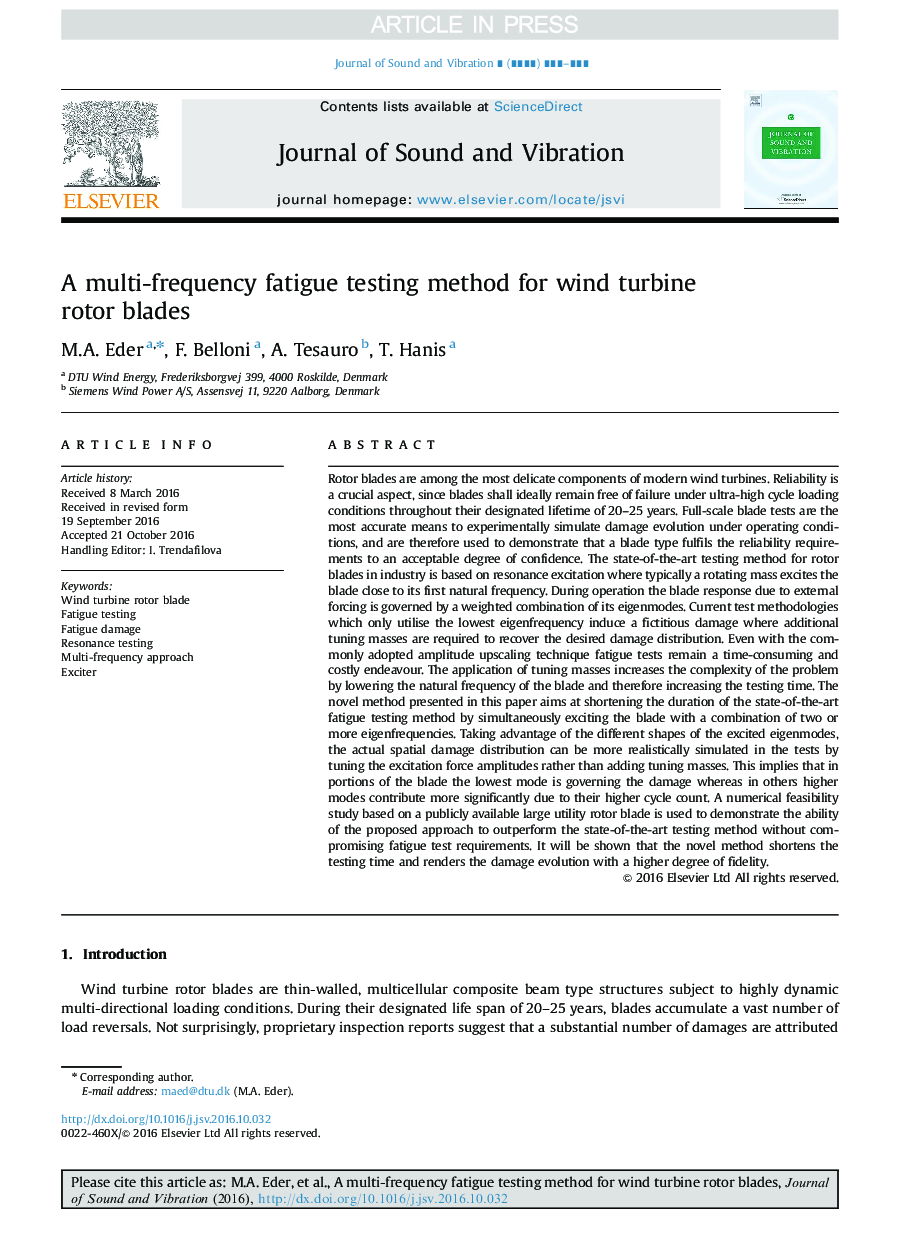| کد مقاله | کد نشریه | سال انتشار | مقاله انگلیسی | نسخه تمام متن |
|---|---|---|---|---|
| 4924408 | 1430845 | 2017 | 18 صفحه PDF | دانلود رایگان |
عنوان انگلیسی مقاله ISI
A multi-frequency fatigue testing method for wind turbine rotor blades
ترجمه فارسی عنوان
یک روش تست خستگی چند فرکانس برای تیغه های روتور توربین بادی
دانلود مقاله + سفارش ترجمه
دانلود مقاله ISI انگلیسی
رایگان برای ایرانیان
کلمات کلیدی
تیغه روتور توربین بادی، تست خستگی، آسیب خزش تست رزونانس، رویکرد چند فرکانس، هیجان انگیز
ترجمه چکیده
تیغه روتور یکی از مؤثرترین قسمتهای توربین بادی جدید است. قابلیت اطمینان یک جنبه حیاتی است؛ از آنجایی که تیغه ها باید در طول زمان تعیین شده خود از 20 تا 25 سال به طور مطلوب از شکست در شرایط بارگذاری چرخه فوق العاده باقی بمانند. تست های تیغه ای در مقیاس وسیع ترین روش برای آزمایش تجربی شبیه سازی تکاملی خسارت در شرایط عملیاتی است و از این رو برای نشان دادن اینکه نوع تیغه مورد نیاز اطمینان را به حد قابل قبول اطمینان می رساند، استفاده می شود. روش تست پیشرفته برای تیغه های روتور در صنعت بر اساس تحریک رزونانس است که در آن معمولا یک توده چرخشی، تیغه نزدیک اولین فرکانس طبیعی خود را تحریک می کند. در طول عملیات، واکنش تیغه به دلیل نیروی خارجی توسط ترکیبی وزنی از الگوهای خاص خود تنظیم می شود. روشهای تست کنونی که فقط از کمترین ریزش خاصی استفاده می کنند، موجب خسارت ناگهانی در جایی که توده های تنظیم اضافی برای بازیابی توزیع آسیب مطلوب مورد نیاز است. حتی با استفاده از تکنیک پیشرفته دامنه بالا، تکنیک های خستگی تلاش های وقت گیر و گران قیمت باقی می مانند. کاربرد توده های تنظیم، پیچیدگی مشکل را با کاهش بسامد طبیعی تیغه افزایش می دهد و بنابراین زمان آزمایش را افزایش می دهد. روش جدید ارائه شده در این مقاله با هدف کوتاه کردن مدت زمان آزمایش روش جدیدی از خستگی، با همکاری هیجان انگیز تیغه با ترکیبی از دو یا چند رشته اختصاصی خود می باشد. با استفاده از اشکال مختلف حالت های مغناطیسی هیجان انگیز، توزیع خسارت فضایی واقعی در واقع می تواند در آزمایش ها با تنظیم دامنه های نیروی تحریک به جای اضافه کردن توده های تنظیم، شبیه سازی شود. این بدان معنی است که در قسمت های تیغه پایین ترین حالت، آسیب را کنترل می کند در حالیکه در حالت دیگر حالت های بالاتر با توجه به شمارش چرخه بالاتری آنها بیشتر است. یک مطالعه امکان سنجی عددی مبتنی بر یک تیغه روتاتور وسیع در دسترس عموم برای نشان دادن توانایی رویکرد پیشنهادی برای غلبه بر روش تست پیشرفته پیشرفته بدون آسیب رساندن به الزامات آزمون خستگی استفاده شده است. نشان داده خواهد شد که روش جدید زمان تست را کوتاه می کند و تکامل آسیب را با درجه بالاتر وفاداری تضمین می کند.
موضوعات مرتبط
مهندسی و علوم پایه
سایر رشته های مهندسی
مهندسی عمران و سازه
چکیده انگلیسی
Rotor blades are among the most delicate components of modern wind turbines. Reliability is a crucial aspect, since blades shall ideally remain free of failure under ultra-high cycle loading conditions throughout their designated lifetime of 20-25 years. Full-scale blade tests are the most accurate means to experimentally simulate damage evolution under operating conditions, and are therefore used to demonstrate that a blade type fulfils the reliability requirements to an acceptable degree of confidence. The state-of-the-art testing method for rotor blades in industry is based on resonance excitation where typically a rotating mass excites the blade close to its first natural frequency. During operation the blade response due to external forcing is governed by a weighted combination of its eigenmodes. Current test methodologies which only utilise the lowest eigenfrequency induce a fictitious damage where additional tuning masses are required to recover the desired damage distribution. Even with the commonly adopted amplitude upscaling technique fatigue tests remain a time-consuming and costly endeavour. The application of tuning masses increases the complexity of the problem by lowering the natural frequency of the blade and therefore increasing the testing time. The novel method presented in this paper aims at shortening the duration of the state-of-the-art fatigue testing method by simultaneously exciting the blade with a combination of two or more eigenfrequencies. Taking advantage of the different shapes of the excited eigenmodes, the actual spatial damage distribution can be more realistically simulated in the tests by tuning the excitation force amplitudes rather than adding tuning masses. This implies that in portions of the blade the lowest mode is governing the damage whereas in others higher modes contribute more significantly due to their higher cycle count. A numerical feasibility study based on a publicly available large utility rotor blade is used to demonstrate the ability of the proposed approach to outperform the state-of-the-art testing method without compromising fatigue test requirements. It will be shown that the novel method shortens the testing time and renders the damage evolution with a higher degree of fidelity.
ناشر
Database: Elsevier - ScienceDirect (ساینس دایرکت)
Journal: Journal of Sound and Vibration - Volume 388, 3 February 2017, Pages 123-140
Journal: Journal of Sound and Vibration - Volume 388, 3 February 2017, Pages 123-140
نویسندگان
M.A. Eder, F. Belloni, A. Tesauro, T. Hanis,
